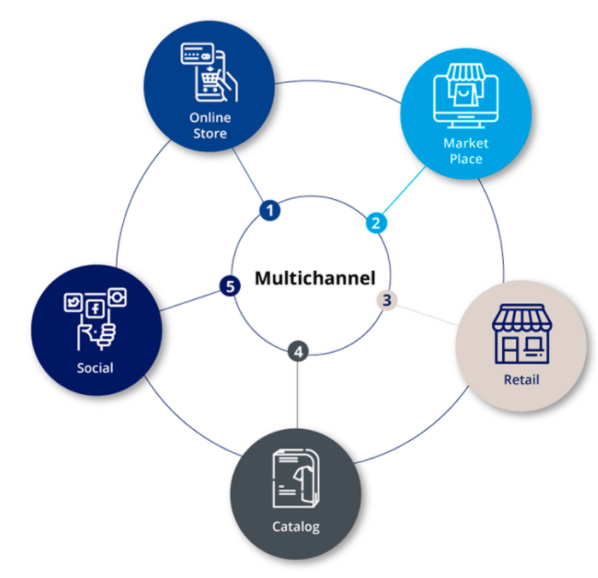Business Leader/Multi-outlet Retailer (1 years course)
Business Leader/Multi-outlet Retailer click here
Brief Job Description
Individuals in this position often run high profitability organizations that own their facilities and equipment. Individuals in this position own or in-charge of more than one retail outlet. They drive business by employing/ supervising/ managing people to manage the operations through systems and processes. Incase of direct selling, individuals drive sales through leading a large team with higher span of control and higher business volumes.

Personal Attributes
The individual needs to be physically fit to be able to fulfil tasks efficiently and be mentally balanced to be
able to motivate self and team to deal with unexpected situations, if any. He/she should also have
business acumen, distributed management skills, people management skills and sales and marketing
skills and customer service skills.
Build relationship with vendors / dealers to ensure smooth business operations and increase sales
Description
This unit deals in building relationships with vendors/dealers.
Elements and Performance Criteria
Build and manage networks with vendors and dealers
To be competent, the user/individual on the job must be able to:
PC1. communicate clearly in the required local language
PC2. articulate clearly and coherently
PC3. respond appropriately
Establish trust and confidence in vendors and partners
To be competent, the user/individual on the job must be able to:
PC4. identify where to get help and information from
PC5. understand what is required from specific vendors
PC6. express need clearly and get into workable relationship with vendor/s
PC7. negotiate with vendors for better deal
PC8. ensure proper contracting with vendors
PC9. ensure minimisation of possible risks and losses in vendor relationships
PC10. understand best practices and maintain cordial relationships
Knowledge and Understanding (KU)
The individual on the job needs to know and understand:
KU1. vendors and ways to connect with them
KU2. local language
KU3. basic offerings by vendors elsewhere
Generic Skills (GS)
User/individual on the job needs to know how to:
GS1. complete documentation accurately
GS2. collate simple data when required
GS3. read information accurately
GS4. read and interpret data sheets
GS5. use gestures or simple words to communicate where language barriers exist
GS6. use questioning to minimize misunderstandings
GS7. display courteous and helpful behavior at all times
GS8. make appropriate decisions regarding the responsibilities of the job role
GS9. plan and organize service feedback files/documents
GS10. schedule daily activities and draw up priorities; allocate start times, estimate completion
times, materials, equipment and assistance required for completion
GS11. build customer relationships and use customer centric approach
GS12. identify problems immediately and take up solutions quickly to resolve delays
GS13. think through the problem, evaluate the possible solution(s) and adopt an optimum /best
possible solution(s)
GS14. data interpretation and its inference
GS15. how to break down complex problems into single and manageable components within his/her
area of work
GS16. apply, analyze, and evaluate the information gathered from observation, experience,
reasoning, or communication, as a guide to thought and action
Manage customer needs effectively through need identification and strong customer relationship
Description
This OS describes the skills and knowledge required to enhance customer satisfaction through customer
experience management.
Scope
The scope covers the following :
Enhance customer satisfaction by identifying and catering to their needs and desires
Building strong relationships and network
Elements and Performance Criteria
Enhance customer satisfaction by identifying and catering to their needs and desires
To be competent, the user/individual on the job must be able to:
PC1. identify target customers
PC2. assess target customer need and desire
PC3. identify possible options to satisfy customer need
PC4. present options in an attractive manner that are mutually beneficial in nature
PC5. establish rapport with customers and express genuine interest to clarify customer
requirements and enhance outcomes
PC6. maximise sales opportunities by use of add-on and complementary sales techniques
PC7. provide customer with detailed information about the product/service
Build strong relationships and network
To be competent, the user/individual on the job must be able to:
PC8. build relationships with customers to generate referrals
PC9. collect feedback to improvise to increase business returns and reach
PC10. manage on time delivery service fulfilment
PC11. implement customer loyalty programs like vouchers, promotions
PC12. plan and implement sales presentations
PC13. acknowledge customer complaints and problems and support difficult customers to produce
positive outcome

PC14. adapt appropriate behaviour and communication standards with customers of different
gender
PC15. adapt the most appropriate method of communication to suit the gender, age and culture of
the customer
PC16. adapt behaviour that is appropriate with customers, colleagues and other external
stakeholders with disability
PC17. respond to people with disabilities in a manner that upholds their self-respect
PC18. explicitly communicate information that are specific to customers with disability
PC19. adapt communication styles and behaviour that are in line with the organisation’s policies for
people with disabilities
PC20. identify and display a nondiscriminatory attitude in all contacts with customers and other
staff members
Knowledge and Understanding (KU)
The individual on the job needs to know and understand:
KU1. the target customer
KU2. acceptable service fulfillment norms
KU3. how to build referrals
KU4. what is a loyalty program
KU5. organisation’s standards and policies on gender equality
KU6. communication methods used to respond in a gender neutral manner
KU7. organisation’s policies and operating procedures with respect to customers with disability
KU8. provisions in law related to workplace and consumer rights for the disabled
Generic Skills (GS)
User/individual on the job needs to know how to:
GS1. complete documentation accurately
GS2. collate simple data when required
GS3. read information accurately
GS4. read and interpret data sheets
GS5. use gestures or simple words to communicate where language barriers exist
GS6. use questioning to minimise misunderstandings
GS7. display courteous and helpful behaviour at all times
GS8. make appropriate decisions regarding the responsibilities of the job role
GS9. plan and organize service feedback files/documents
GS10. use language and concepts appropriate to cultural and gender differences
GS11. schedule daily activities and draw up priorities; allocate start times, estimate completion
times, materials, equipment and assistance required for completion
GS12. build customer relationships and use customer centric approach
GS13. identify problems immediately and take up solutions quickly to resolve delays
GS14. think through the problem, evaluate the possible solution(s) and adopt an optimum /best
possible solution(s)
GS15. interpret and infer data
GS16. how to break down complex problems into single and manageable components within his/her
area of work
GS17. apply, analyze, and evaluate the information gathered from observation, experience,
reasoning, or communication, as a guide to thought and action
Implement legal compliances, policies and procedures
Description
This unit deals in sub tasks that lead to effective implementation of legal compliances, policies and
procedures for managing a business.
Elements and Performance Criteria
Liaison and interact with local corporations and government bodies for smooth conduct of business
To be competent, the user/individual on the job must be able to:
PC1. identify local corporations and government bodies that have a bearing on the
particular business
PC2. identify the contact persons of the particular corporations and government bodies
PC3. interact and maintain relationships with the key persons to ensure smooth
functioning of business
Awareness of self and team on legal compliance, different forms of contracts and agreements, legal
aspects of financial transactions, quality norms and legal requirements with regards to sale of products
and services
To be competent, the user/individual on the job must be able to:
PC4. determine key elements of major legal oversight systems affecting business
operations and follow relevant rules and policies
PC5. compare various issues affecting different forms of contract and agreements
within business operations
PC6. ensure team conformance to the relevant rules and policies for smooth
functioning of business
PC7. describe the concept of minimizing losses and maximizing gains
PC8. articulate legal aspects of financial transactions within business operations
PC9. describe legal requirements for the sale of products and services
PC10. describe various methods of regulating patents and trademarks in local business
environment
Awareness of safety hazards and implement policies and procedures to ensure goods are handled, stored
and transported safely and according to requirements for dangerous and hazardous materials
To be competent, the user/individual on the job must be able to:
PC11. identify and adhere to policies and procedures to ensure goods are handled,
stored and transported safely and according to requirements for dangerous and
hazardous materials
PC12. ensure security checks and balances are conducted to prevent hazards and risks
involved in the business process
PC13. describe ways and means to handle emergencies and mitigate risks
PC14. record, store and transfer information according to legislative and business
requirements
Knowledge and Understanding (KU)
The individual on the job needs to know and understand:
KU1. local corporations/authorities that have a bearing on the particular business
KU2. policies and procedures that have a bearing on the particular business
KU3. legal formalities applicable for the particular business
KU4. knowledge of systems and processes involved in the business
KU5. hazards and risks involved in the business
Generic Skills (GS)
User/individual on the job needs to know how to:
GS1. complete legal documentation accurately
GS2. collate legal data when required
GS3. read legal documentation and related information accurately
GS4. read and interpret agreements, legal documents

GS5. use gestures or simple words to communicate where language barriers exist
GS6. use questioning to minimise misunderstandings
GS7. display courteous and helpful behaviour at all times
GS8. make appropriate decisions regarding related to legal procedures and policies
GS9. prioritize activities and schedule daily activities accordingly; allocate start times, estimate
completion times, documentation, material and assistance required for completion.
GS10. build strong relationships with representatives from local corporations, government
organizations
GS11. identify problems immediately and take up solutions quickly to resolve problems, deviations
and delays
GS12. evaluate the problem, identify possible solution(s) and adopt an optimum /best possible
solution(s)
GS13. interpret data and legal documentation and arrive at inference
GS14. break down complex problems into single and manageable component within the scope of
responsibility
GS15. apply, analyze, and evaluate the information gathered from observation, experience,
reasoning, or communication, as a guide to thought and action
Manage inventory and sales
Description
This unit is about ensuring appropriate market analysis to ensure that the right product is stocked in right
quantities and sold in the correct manner.
Scope
The scope covers the following :
Conduct market analysis to identify customer and plan product assortment/stocks accordingly
Ensure effective management of Inventory and Sales
Elements and Performance Criteria
Conduct market analysis to identify need and plan assortment/stocks accordingly
To be competent, the user/individual on the job must be able to:
PC1. identify target audience/consumer profile
PC2. identify buying patterns and analyse sales data to define assortments and modify them as
per trends observed
PC3. understand competitors/other players/substitute products
PC4. determine means to forecast demands on inventory
PC5. describe the importance for monitoring market trends and technology changes as part of
managing inventory demands
Effective inventory and sales management
To be competent, the user/individual on the job must be able to:
PC6. describe inventory/procuring capacity as per demand
PC7. determine required inventory is on hand
PC8. monitor stock levels and maintain at required levels
PC9. coordinate stockade or cyclical count
PC10. understand operational costs
PC11. define targets for self and team to achieve business gains
PC12. match logistics of delivery to inventory supply requirements
PC13. calculate profits and margins
PC14. take steps to prevent inventory losses
PC15. plan for contingencies in case of stock out
Knowledge and Understanding (KU)
The individual on the job needs to know and understand:
KU1. products/services involved in the business
KU2. related products/services
KU3. competitors and substitutes
KU4. all costs involved
KU5. possible contingencies
KU6. equipment involved in the business
KU7. calculating various costs
KU8. possible sources of losses
Generic Skills (GS)
User/individual on the job needs to know how to:
GS1. complete inventory and sales-related documentation accurately
GS2. collate market information data when required
GS3. read market research reports, inventory and sales-related information accurately
GS4. read and interpret market research data, inventory and sales-related information
GS5. use gestures or simple words to communicate where language barriers exist
GS6. use questioning to minimise misunderstandings within team or any other stakeholder
GS7. display courteous and helpful behaviour to the team at all times
GS8. make appropriate decisions regarding the responsibilities of the job role
GS9. plan for conducting market research and demand forecast

GS10. schedule daily activities; help team prioritise and organise tasks, allocate start times,
estimate completion times, materials, equipment and assistance required for completion.
GS11. build customer relationships with vendors by using customer centric approach
GS12. identify problems immediately and take up solutions quickly to resolve delays
GS13. think through the problem, evaluate the possible solution(s) and adopt an optimum /best
possible solution(s)
GS14. interpret and infer market research data
GS15. analayse impact of various factors on current and future demand for inventory
GS16. break down complex problems into single and manageable components within his/her area
of work
GS17. apply, analyze, and evaluate the information gathered from observation, experience,
reasoning, or communication, as a guide to thought and action
Manage financial operations
Description
This unit is about understanding and implementation of financial activities critical to business.
Scope
The scope covers the following :
Prepare and manage financial budget
Maintain Profit and Loss Accounts and business accounting systems
Take measures to control costs
Negotiate and generate credit from vendors/suppliers
Raise additional funds for business expansion
Establish trading terms for the business
Elements and Performance Criteria
Prepare and manage financial budget
To be competent, the user/individual on the job must be able to:
PC1. describe business policy and procedures in regard to preparation of budget or target figures
PC2. present proposed budgets or targets accurately and concisely to the concerned stakeholders
PC3. negotiate necessary changes to agreed budget allocations if necessary
PC4. monitor income and expenditure and maintain expenditure within budget targets according
to business policy
PC5. take prompt corrective action where significant deviations from budget occur
PC6. enforce budget audit mechanisms and compliance requirements
Maintain Profit and Loss Accounts and business accounting systems
To be competent, the user/individual on the job must be able to:
PC7. ensure team ability to conduct basic accounting tasks, creating and maintaining reports
PC8. build team ability to analyse sources of profits and causes of losses as reflected in the
reports
PC9. ensure implementation of checks to prevent monetary losses due to fraudulent activities
PC10. monitor and maintain business systems for recording sales figures, revenue, personnel and
payroll information, and expenditure
Take measures to control costs
To be competent, the user/individual on the job must be able to:
PC11. implement cost reduction measures according to business policy and procedures
PC12. encourage team members to actively control costs in their areas of responsibility
PC13. implement recommendations for improving cost reduction or communicate to the team
Negotiate and generate credit from vendors/suppliers
To be competent, the user/individual on the job must be able to:
PC14. describe the business cycle from accounting point of view
PC15. calculate credit amount, credit period, break-even point and payment schedules
PC16. define vendor credit cycle to ensure smooth borrowing process
PC17. negotiate to arrive at the most profitable vendor relationship for the organization and finalize
credit cycle
Raise additional funds for business expansion
To be competent, the user/individual on the job must be able to:
PC18. identify credit sources for business expansion
PC19. describe the terms and conditions of sources offering credit
PC20. identify risks involved in each of sources be considered
PC21. select suitable source of credit
Establish trading terms for the business
To be competent, the user/individual on the job must be able to:
PC22. define processes for approving trading terms
PC23. establish supplier trading terms
PC24. define business customer/direct customer trading terms
PC25. approve trading terms according to business policy and procedures
Knowledge and Understanding (KU)
The individual on the job needs to know and understand:
KU1. organization financial status
KU2. shareholder expectation
KU3. investment mix
KU4. business expansion plans
KU5. reporting forms and formats of the organization
KU6. elements, specific to business, that need to be considered for budgeting and accounting
KU7. risks management while expanding business
KU8. systems that enable timely collection, management and processing of information
Generic Skills (GS)
User/individual on the job needs to know how to:
GS1. complete accounting / financial documentation accurately
GS2. maintain accurate and up to date records of resource allocation and usage according to
company guidelines
GS3. complete records of budget performance and expenditure and report according to company
procedures and guidelines
GS4. read information accurately
GS5. assess and interpret information on costs and resource allocation
GS6. use gestures or simple words to communicate where language barriers exist
GS7. use questioning to minimise misunderstandings
GS8. display courteous and helpful behaviour at all times
GS9. make appropriate decisions regarding the responsibilities of the job role
GS10. plan and organize service feedback files/documents
GS11. schedule daily activities and draw up priorities; allocate start times, estimate completion
times, materials, equipment and assistance required for completion
GS12. build customer relationships and use customer centric approach
GS13. identify problems immediately and take up solutions quickly to resolve delays
GS14. think through the problem, evaluate the possible solution(s) and adopt an optimum /best
possible solution(s)
GS15. interpret and infer financial data
GS16. break down complex problems into single and manageable components within his/her area
of work
GS17. apply, analyze, and evaluate the information gathered from observation, experience,
reasoning, or communication, as a guide to thought and action
Manage business operations
Description
This unit is about business management activities.

Scope
The scope covers the following :
Compare and learn from existing similar businesses
Develop short-term and long-term business plans
Establish strategy and performance requirements
Drive performance of the business
Oversee and develop team members
Elements and Performance Criteria
Compare and learn from existing similar businesses
To be competent, the user/individual on the job must be able to:
PC1. describe similar businesses
PC2. conduct SWOT (Strength, Weakness, Opportunities, Threats) as compared to external market
PC3. identify dos and donts for the business
Develop short-term and long-term business plans
To be competent, the user/individual on the job must be able to:
PC4. identify, assess and prioritize risks
PC5. make short-term and long-term business plans and express actions for the planned project
PC6. define milestones and break them into achievable targets
Establish strategy and performance requirements
To be competent, the user/individual on the job must be able to:
PC7. audit current performance of business to identify opportunities for increased performance
PC8. analyse the location, market focus and performance of competitors
Drive performance of the business

To be competent, the user/individual on the job must be able to:
PC9. identify, cost and budget the resources required to support the implementation of business
strategy
PC10. communicate the business strategy and individual performance requirements to team
members
PC11. establish and communicate to stores/business a schedule of visits to oversee and support
operations
PC12. establish and maintain effective communication and feedback mechanisms to manage
performance and inform adjustments to strategy based on changing circumstances
PC13. provide effective and actionable advice to staff to ensure high-quality merchandising, stock
management and selling






